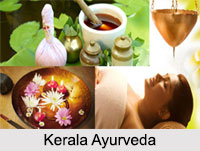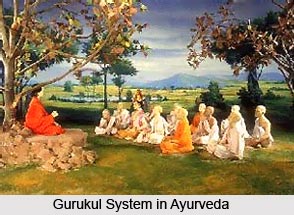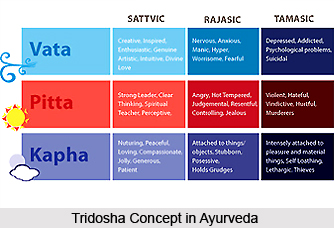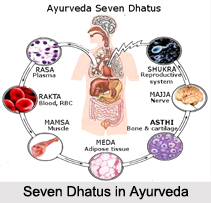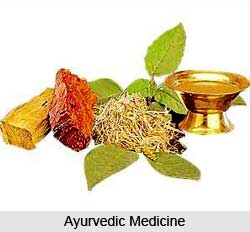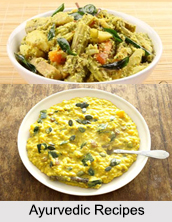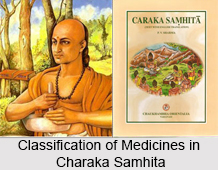 Charaka was a legendary authority on medicine. The science of medicine on the basis of Charaka is widely practiced even now in India. Charaka divides material objects into 3 classes, namely; Mineral, Animal and Vegetable.
Charaka was a legendary authority on medicine. The science of medicine on the basis of Charaka is widely practiced even now in India. Charaka divides material objects into 3 classes, namely; Mineral, Animal and Vegetable.
Minerals: They consist, of gold, silver and other metals; diamond, emerald and other gems; realgar, orpiment and other ores; and the various sorts of earths.
Animals: They are divided into 4 classes, namely, "Jardyuja" or mammalian, "Andaja" or oviparous, "Svedaja" or those produced from Animal excretions, as parasites, etc., and "Udbhijja" or those produced under ground or from vegetable matter, as for example Indragopa, a sort of red insect. The skin, hair, wool, nails, horns, hoofs, milk, bile, honey, fat, marrow, blood, flesh, urine, faeces, semen, bones and nerves of animals are all used in medicine.
Vegetables: They are divided into 4 classes, namely, "Vanaspati", "Vriksha", "Virudh" and "Oshadhi". Those plants which produce fruits, without first showing their flowers, are called "Vanaspati". Plants which produce fruits from flowers and which have small branches from their trunks are called "Vriksha". Plants which during their growth are supported by other plants are called "Virudh". Lastly, those grasses, etc. which die after maturing their fruits, are called "Oshadhi".
All parts of vegetables may be used in medicine, namely;
•Root, as of "Chitraka".
•Under ground stem as of "Surana".
•Leaves, as of "Vasaka".
•Fruits, as the three "Myrubalans".
•Flowers, as of "Dhataki".
•Extract, as Catechu, Opium, etc.
•Bark, as of "Kureki".
•Wood, as of "Darvi".
•Gum, as Myrrh, Asafoetida, etc.
•Sometimes the entire plant is used as "Kantakari".
Sanskrit writers do not agree in the mode in which they classify medicines when describing their properties. Charaka divides medicines into 50 classes, according to their supposed action on the different organs of the system, or on particular symptoms of disease. These classes are as follows:
1. "Jivaniya"- Medicines which prolong life.
2. "Vrinhaniya"- Medicines which promote nutrition and increase corpulency.
3. "Lekhaniya"- Medicines which thin the tissues, or reduce corpulency.
4. "Bheduniya"- Promote excretions.
5. "Sandhaniya"- Promote the union of fractured or divided parts.
6. "Dipaniya"- Increase the appetite and digestive.
7. "Balya"- Increase strength, tonics.
8. "Varnya"- Improves the complexion.
9. "Kanthya"-Improves the voice, cure hoarseness.
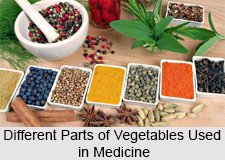 10. "Hridya"- Promote cheerfulness or relish.
10. "Hridya"- Promote cheerfulness or relish.
11. "Triptighna"- Remove supposed phlegm which causes a sense of satiety.
12. "Arsoghna"- Cure piles.
13. "Kushthaghna"- Cure skin diseases.
14. "Kandughna"- Cure pruritus.
15. "Krimighna"- Cure worms.
16. "Vishaghna"- Acts as antidotes to poisons.
17. "Stanyajanana"- Promote secretion of milk.
18. "Stanyasodhana"- Improves the quality of milk.
19. "Sukrajanana"- Increases the secretion of semen.
20. "Sukrasodhana"- Purify the semen.
21. "Snehopayoga"- Emollients.
22. "Svedopayoga"- Diaphoretics.
23. "Vamanopayoga"- Emetics.
24. "Virechanopayoga"- Purgatives.
25. "Asthapanopayoga"- Medicines for use in enemas.
26. "Anuvasanopayoga"- Medicines for oily enemas.
27. "Sirovirechanopayoga"- Promote discharge from the nose.
28. "Chhardinigrahana"- Relieve vomiting.
29. "Trishnanigrahana"- Relieve thirst.
30. "Hikkanigrahana"- Relieve hiccup.
31. "Purishasanqrahaniya"- Render the faeces consistent.
32. "Purishavirajaniya"- Alter the colour of the faeces
33. "Mutrasangrahaniya"- Reduce secretion of urine.
34. "Mutravirajaniya"- Alter colour of urine.
35. "Mutravirechaniya"- Increase secretion of urine.
36. "Kasahara"- Cure cough.
37. "Svasahara"- Cure difficult breathing or asthma.
38. "Sothahara"- Cure anasarca or swellings.
39. "Jvarahara"- Febrifuges.
40. "Sramahara"- Remove fatigue.
41. "Dahaprasamana"- Relieve burning or heat of body.
42. "Sitaprasamana"- Relieve sense of coldness.
43. "U`darddhaprasamana"- Cure urticaria.
44. "Angamarddaprasamana"- Relieve pain in the limbs.
45. "Sulaprasamana"- Cure pain in the bowels.
46. "Sonitasthapana"- Styptics.
47. "Vedanasthapana"- Anodynes.
48. "Sanjuasthapana"- Restore consciousness.
49. "Prajasthapana"- Cure sterility.
50. "Vayahsthapana"- Prevents the effect of age.
Related Articles
Ayurveda
History of Ayurveda
Origin of Ayurveda
Charaka Samhita
Ayurveda Medication
Principles Of Ayurveda
Elements of Ayurveda
Concepts of Ayurveda
Branches of Ayurveda
Ancient Literature of Ayurveda
